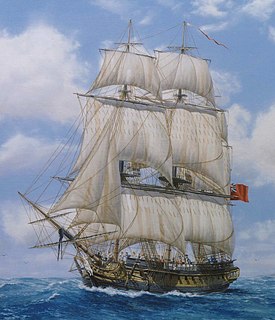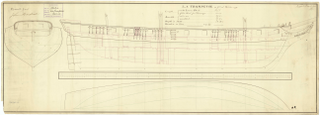Twelve ships of the Royal Navy have been named HMS Active or HMS Actif, with a thirteenth announced:

Eighteen ships of the Royal Navy have borne the name HMS Mercury, or HMS Mercure, after the God Mercury, of Roman mythology:
Jean Bart may refer to one of the following ships of the French Navy or privateers named in honour of Jean Bart, a French naval commander and privateer.

Révolutionnaire, was a 40-gun Seine-class frigate of the French Navy, launched in May 1794. The British captured her in October 1794 and she went on to serve with the Royal Navy until she was broken up in 1822. During this service Revolutionnaire took part in numerous actions, including three for which the Admiralty would in 1847 award clasps to the Naval General Service Medal, and captured several privateers and merchant vessels.
Thirteen ships of the Royal Navy have borne the name HMS Experiment:

America was a Téméraire-class 74-gun ship of the line of the French Navy. The Royal Navy captured her in 1794 at the Battle of the Glorious First of June. She then served with the British under the name HMS Impetueux until she was broken up in 1813. She became the prototype for the Royal Navy America-class ship of the line.

HMS Melampus was a Royal Navy fifth-rate frigate that served during the French Revolutionary and Napoleonic Wars. She captured numerous prizes before the British sold her to the Royal Netherlands Navy in 1815. With the Dutch, she participated in a major action at Algiers and, then, in a number of colonial punitive expeditions in the Dutch East Indies.

HMS Trompeuse was the French privateer Mercure, captured in 1799. She foundered in the English Channel in 1800.

HMS Lark was a 16-gun ship sloop of the Cormorant class, launched in 1794 at Northfleet. She served primarily in the Caribbean, where she took a number of prizes, some after quite intensive action. Lark foundered off San Domingo in August 1809, with the loss of her captain and almost all her crew.
During the French Revolutionary and Napoleonic Wars Égyptienne, or Egypt, which commemorated Napoleon's Egyptian Campaign, was a popular name for French vessels, including naval vessels and privateers. Between 1799 and 1804, warships of the Royal Navy captured one French frigate and five different French privateers all with the name Egyptienne, and at least one privateer with the name Egypte.
During the French Revolutionary War Trompeuse, meaning “misleading” or “deceptive”, was a popular name for French naval vessels, privateers, and even merchant vessels. Warships of the Royal Navy captured or destroyed at least four vessels under that name.
Several French ships have borne the name Courageux, Courageaux, or Courageuse:
Numerous French naval vessels have borne the name Résolue, the French for "Resolute", as have several privateers.
Seven ships of the French Navy have borne the name Sans-Culotte in honour of the Sans-culottes:
Three vessels of the French Navy have borne the name Hardi, the name being the French word for "daring":
Numerous French privateers have borne the name Vengeur ("Avenger"):
HMS Trompeuse was a former French 16-gun brig-sloop, launched in July 1793, that HMS Sphinx captured on 12 January 1794 near Cape Clear Island. The British Royal Navy took her into service. As HMS Trompeuse she captured a small privateer and then grounded off Kinsale in 1796.

HMS Trompeuse was the French privateer brig Coureur that the British Royal Navy captured in 1800. She was sold for breaking up in 1811.
Between 1793 and 1805, five cutters served the British Royal Navy as hired armed vessels under the designation HM hired cutter Rose:
This page is based on this
Wikipedia article Text is available under the
CC BY-SA 4.0 license; additional terms may apply.
Images, videos and audio are available under their respective licenses.





